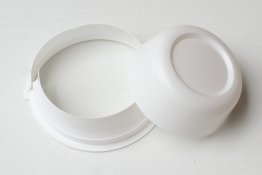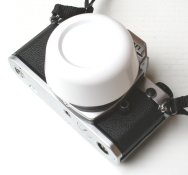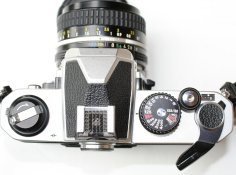Jon Goodman
Member
In line with the other specials, I have 10 kits to offer for the Olympus OM1 / OM2 (or OM3 and OM4) models. Just like the other kits, these will be $8 each kit (sent anywhere) and payment will be mail-in for people in the USA whereas I can accept PayPal for folks in other countries. Please send me an email (to jon_goodman@yahoo.com) with your mailing address and tell me how many kits you want. Please limit yourself to 2 kits. I'll give you my mailing address or my PayPal email address at that time and we can rest easier knowing your OM will be all nice and ready for vacation. You will need to remind me to send you the instructions via email as they won't be printed and included with the kit at this price.
I'm chipping away at the cost of repair or replacement of the BBQ grill of death (please see the Minolta Special offer for more details) but very slowly. Given the nature of Texas and the incredible amount of sun we get here, my wife thinks I should direct my energies toward developing a solar grill, but I'm much more interested in a solar powered air conditioner. I'm not sure the technology is there yet, however.
Was that the answer to the burning question? Nope, it wasn't. Before I tell you the question and the answer, I'll tell you I find it interesting that even facing declining use of film and film cameras I still receive an average of over 60 email messages each day...mostly containing questions about cameras. And a question that is repeated almost once each week (and sometimes it seems to recur nearly every day) is "how can I check the meter in my camera?" There are lots of different answers, and probably none of them will be wrong, but here's a simple method I have trusted for decades:
1. Eat a carton of yogurt or if you have lactose intolerance or milk allergies in your family, have your least favorite child eat it. Yoplait Greek yogurt is a good one. When you're finished, wash and dry the plastic container well. You can also use a styrofoam coffee cup (the kind you get at hospital waiting rooms), but the yogurt container will be much more long-lasting and I think bringing it closer to the lens helps your reading be more correct.
2. Using scissors or a knife, carefully remove the plastic wrapping from the white carton. Once you get it started, it should be pretty easy to peel off. When you've done that, use scissors (or a knife) to carefully cut about an inch off the top of that carton, leaving you with a smaller and more shallow carton as in image 1 below.
3. This smaller carton should fit over a typical 50mm (or 35mm or any similar) lens. I would not use a zoom lens if I were you. You can see this in image 2 below. The end should fit nicely against the lens end.
4. Set your camera as I've done in image 3 below. ASA set to 125 (or 100 if 125 isn't a possible choice for you). Shutter speed to 1/125. Aperture set to 16 (or a bit past 16 if you must use ASA 100 speed). Now with the yogurt container held over your lens, go outside on a cloudless day and point your lens right at the sun. Your meter should see this scheme as ideal. If your meter reads a bit + or - in this scenario, you'll at least know what the right correction factor is...example 1/4 stop, 1/2 stop, etc.
Please let me know if you have any questions.
Jon
I'm chipping away at the cost of repair or replacement of the BBQ grill of death (please see the Minolta Special offer for more details) but very slowly. Given the nature of Texas and the incredible amount of sun we get here, my wife thinks I should direct my energies toward developing a solar grill, but I'm much more interested in a solar powered air conditioner. I'm not sure the technology is there yet, however.
Was that the answer to the burning question? Nope, it wasn't. Before I tell you the question and the answer, I'll tell you I find it interesting that even facing declining use of film and film cameras I still receive an average of over 60 email messages each day...mostly containing questions about cameras. And a question that is repeated almost once each week (and sometimes it seems to recur nearly every day) is "how can I check the meter in my camera?" There are lots of different answers, and probably none of them will be wrong, but here's a simple method I have trusted for decades:
1. Eat a carton of yogurt or if you have lactose intolerance or milk allergies in your family, have your least favorite child eat it. Yoplait Greek yogurt is a good one. When you're finished, wash and dry the plastic container well. You can also use a styrofoam coffee cup (the kind you get at hospital waiting rooms), but the yogurt container will be much more long-lasting and I think bringing it closer to the lens helps your reading be more correct.
2. Using scissors or a knife, carefully remove the plastic wrapping from the white carton. Once you get it started, it should be pretty easy to peel off. When you've done that, use scissors (or a knife) to carefully cut about an inch off the top of that carton, leaving you with a smaller and more shallow carton as in image 1 below.
3. This smaller carton should fit over a typical 50mm (or 35mm or any similar) lens. I would not use a zoom lens if I were you. You can see this in image 2 below. The end should fit nicely against the lens end.
4. Set your camera as I've done in image 3 below. ASA set to 125 (or 100 if 125 isn't a possible choice for you). Shutter speed to 1/125. Aperture set to 16 (or a bit past 16 if you must use ASA 100 speed). Now with the yogurt container held over your lens, go outside on a cloudless day and point your lens right at the sun. Your meter should see this scheme as ideal. If your meter reads a bit + or - in this scenario, you'll at least know what the right correction factor is...example 1/4 stop, 1/2 stop, etc.
Please let me know if you have any questions.
Jon









